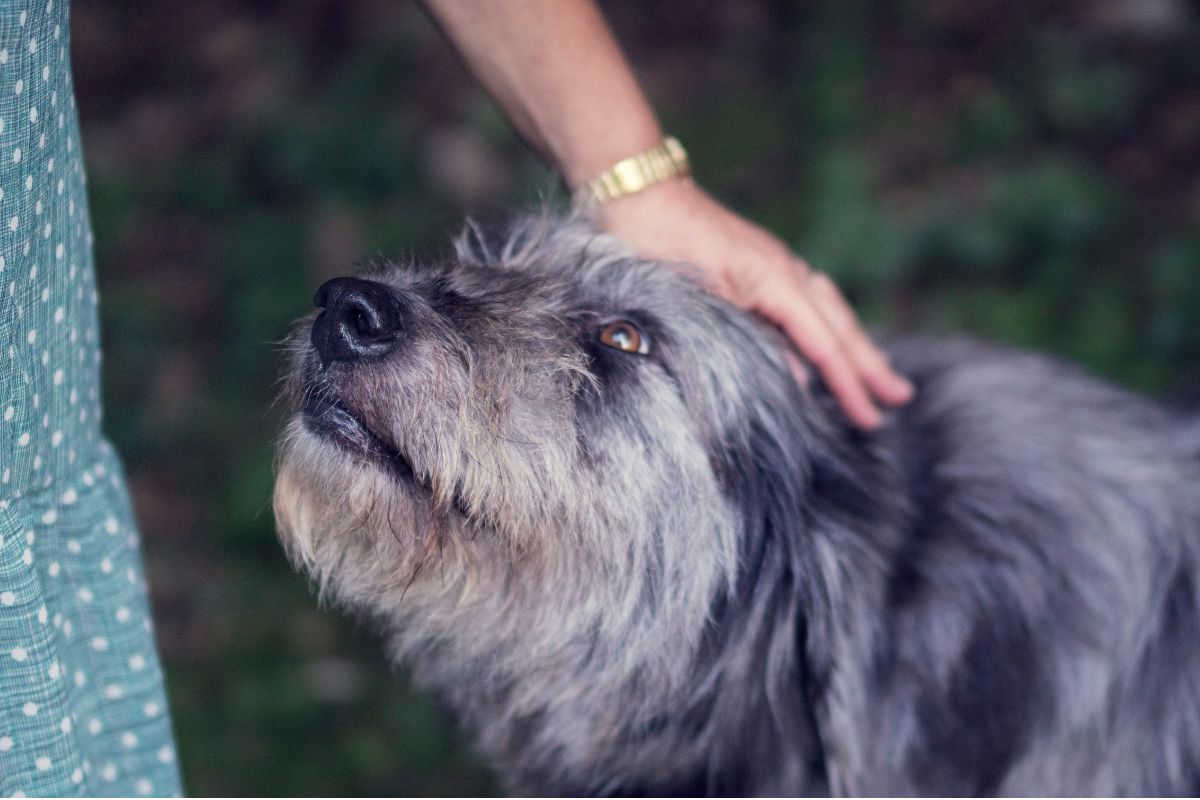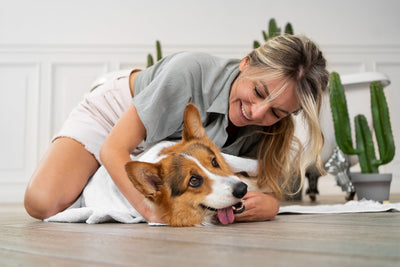Senior Dog Nutrition Guide: When to Switch & What to Feed Your Aging Dog
Is your beloved dog starting to slow down on walks or showing less interest in their food? These subtle changes might signal it's time to rethink their nutritional needs.
As our canine companions enter their golden years, their bodies undergo significant changes that directly impact how they process and benefit from food. Caring for senior dogs requires a thoughtful approach to their changing nutritional needs. As pets age, their metabolism slows, activity levels decline, and underlying health issues may begin to surface- all of which can significantly impact how their bodies process and benefit from food.
This article covers the essential nutritional requirements and dietary considerations for senior dogs, explaining when to transition to senior nutrition, what nutrients aging dogs need, and how to choose the right diet based on breed size and health status.

ON THIS PAGE
Is your furry friend slowing down, gaining weight, or showing less interest in their regular kibble? These could be signs your dog needs senior nutrition. Knowing when and how to transition your aging companion to senior dog food can add healthy, happy years to their life.
This complete guide covers everything pet parents need to know about senior dog nutrition—from identifying when your dog becomes "senior" to choosing the right food for their breed size and health needs.
📅 What Age Is Considered Senior for Dogs?
The answer isn't one-size-fits-all. While most dogs reach senior status around 7-10 years old, your dog's size plays a huge role in this timeline:
📏 Senior Age by Breed Size:
- 🐕 Small breeds (under 10 kgs): 10-12 years old
- 🐕🦺 Medium breeds (10-25 kgs): 8-10 years old
- 🦮 Large breeds (25-45 kgs): 6-8 years old
- 🐕🦺 Giant breeds (over 45 kgs): 5-6 years old
Why the difference? Larger dogs age faster due to their accelerated growth and metabolism. A Great Dane at 6 years old faces similar age-related changes as a Chihuahua at 10.
🚨 Signs Your Dog Needs Senior Food
Watch for these key indicators:
😴 Reduced activity or reluctance to exercise
🍽️ Appetite changes or eating difficulties
⚖️ Weight gain or unexplained weight loss
💩 Digestive issues or stool changes
🦷 Dental problems affecting eating
💧 Increased thirst or urination
🧥 Dull coat or skin condition changes
⚠️ Don't wait for multiple symptoms—early transition prevents age-related health issues.
🧬 Why Do Senior Dogs Need Special Food?
Senior dog food isn't just marketing. These specialized diets address real physiological changes that happen as dogs age:
🍃 Supporting Digestive Health
Problem: Aging reduces enzyme activity
Solution: Highly digestible proteins and carbs
Benefit: Better nutrient absorption, less strain
🛡️ Preventing Age-Related Diseases
Targeted nutrition helps slow kidney disease, heart disease, arthritis, diabetes, and cognitive decline through:
🫘 Reduced phosphorus for kidney health
🐟 Omega-3 fatty acids for joints and brain
🍇 Antioxidants for immune support
💪 Maintaining Muscle Mass
High-quality protein preserves lean muscle while controlling calories to prevent weight gain.
🧪 Senior Dog Nutrition Requirements: What Your Dog Really Needs

🥩 Protein: Quality Over Quantity
💡 Myth Buster: Senior dogs don't need less protein—they need better protein.
Daily Requirements:
- Minimum: 4.0g protein per kg body weight daily
- Best Sources: High-quality animal proteins (chicken, fish, lamb)
- Key Point: Unless diagnosed with kidney disease, senior dogs often need MORE protein, not less
🧈 Fat Content: The Goldilocks Zone
📊 Recommended Level: 8-15% dry matter
- ⚡ Provides concentrated energy for underweight seniors
- ✨ Delivers essential fatty acids for skin, coat, and brain health
- 😋 Improves food palatability
🐠 Omega-3 Fatty Acids for Senior Dogs
- 📏 Daily Dosage: 70-100mg EPA + DHA per kg body weight
- 🎯 Benefits: Reduces inflammation, improves joint health, enhances cognitive function
- 🌟 Best Sources: Fish oil, salmon, sardines
🌾 Fiber for Digestive and Weight Support
📊 Recommended Level: 2-5% dry matter
- 🦠 Soluble fiber: Feeds beneficial gut bacteria
- 🌱 Insoluble fiber: Promotes healthy digestion and satiety
- ⚖️ Weight management: Helps overweight dogs feel full with fewer calories
💊 Essential Vitamins and Minerals for Senior Dogs
| Nutrient | Purpose | Benefits |
|---|---|---|
| 🛡️ Vitamin E & C | Antioxidant protection | Reduces cellular damage, supports immune function |
| ⚡ B Vitamins | Energy metabolism | Supports neurological health and energy production |
| 🦴 Glucosamine & Chondroitin | Joint support | May help maintain cartilage and reduce arthritis symptoms |
| 🫘 Reduced Phosphorus | Kidney protection | Lessens burden on aging kidneys |
| 🧂 Moderate Sodium | Heart health | Supports cardiovascular function without strain |
🏆 Best Senior Dog Food by Breed Size

🐕 Small Breed Dogs
Needs: Higher metabolism, small kibble, dental support
Top Brands:
- Hill's Science Diet Senior 11+ Small Paws - Easy-to-digest, balanced nutrition
- Royal Canin Small Aging - Antioxidants, rehydratable kibble
🦮 Large & Giant Breed Dogs
Needs: Joint support, controlled calories, kidney protection
Top Brands:
- Royal Canin Large Aging Adult - Joint nutrients, calorie control
- Hill's Science Diet Adult 7+ Large Breed - Glucosamine formula
- Purina Pro Plan Bright Mind - Brain-supporting botanical oils
🍽️ How Much Should I Feed My Senior Dog?
Caloric needs vary by activity level:
| Activity Level | Calories per kg/day | Protein % | Special Considerations |
|---|---|---|---|
| 🏃 Active/Working | 95-130 kcal | 22-28% | Higher energy, more frequent feeding |
| 🚶 Moderate | 85-100 kcal | 20-25% | Standard senior formulation |
| 😴 Sedentary | 80-95 kcal | 18-22% | Weight management focus, added fiber |
📏 Monitor your dog's body condition score every 4-6 weeks and adjust portions accordingly.
❌ Common Senior Dog Feeding Mistakes to Avoid
❌ Mistake #1: "Senior dogs need low-protein diets"
✅ Reality: Unless diagnosed with chronic kidney disease, senior dogs benefit from high-quality, easily digestible animal protein. Reducing protein unnecessarily accelerates muscle loss.
❌ Mistake #2: Continuing to feed like a young adult
- ⚠️ Problem: Overfeeding due to reduced activity leads to obesity
- ✅ Solution: Adjust portions based on current weight and activity level, not past habits
❌ Mistake #3: "Dry food is always better for dental health"
✅ Reality: Senior dogs with dental issues may find dry food painful. Better approach: Consider soaked kibble, wet food, or dental-specific diets with proper dental care.
❌ Mistake #4: Abrupt diet changes
- ⚠️ Problem: Older dogs have sensitive digestive systems
- ✅ Solution: Transition new foods gradually over 7-10 days
❌ Mistake #5: Relying on supplements alone
✅ Reality: Supplements can't fix a poor-quality base diet. Better approach: Focus on complete, balanced senior nutrition first, then add targeted supplements under veterinary guidance.
🔄 How to Switch to Senior Dog Food: Step-by-Step Guide
📋 Step 1: Assess Your Dog's Current Condition
- ⚖️ Body weight and condition score
- 🏃 Activity level and mobility
- 🏥 Any existing health conditions
- 🍽️ Current eating habits and preferences
🛒 Step 2: Choose the Right Senior Dog Food
- 🏆 Look for AAFCO statement for senior dogs
- 📏 Consider breed size-specific formulations
- 🌟 Evaluate ingredient quality and digestibility
- 🎯 Check for targeted nutrients (omega-3s, antioxidants, joint support)
📅 Step 3: Transition Gradually
- Week 1: 75% old food, 25% new food
- Week 2: 50% old food, 50% new food
- Week 3: 25% old food, 75% new food
- Week 4: 100% new food
👀 Step 4: Monitor and Adjust
- 🔍 Watch for digestive upset, appetite changes, or energy level shifts
- ⚖️ Weigh regularly and adjust portions as needed
- 🩺 Schedule regular veterinary checkups
🩺 When to Consult Your Veterinarian About Senior Dog Nutrition
Contact your vet immediately if your senior dog experiences:
- ⚖️ Sudden weight loss or gain
- 🚫 Loss of appetite lasting more than 24 hours
- 💩 Digestive issues or changes in stool
- 💧 Increased thirst or urination
- 😣 Difficulty chewing or swallowing
- 😰 Signs of pain or discomfort
💡 Pro Tips for Senior Dog Feeding Success
⏰ Start early - Consider senior food at 6-7 years (large breeds), 8-9 years (small breeds)
⚖️ Weigh monthly - Catch changes early
🍽️ Smaller, frequent meals - 2-3 times daily
🔥 Warm wet food - Enhances aroma for picky eaters
⏰ Consistent routine - Regular meal times reduce anxiety
🧩 Puzzle feeders - Mental stimulation while eating
📝 Keep food diary - Track habits for vet visits
⬆️ Elevated bowls - Comfort for arthritic dogs
💊 Check interactions - Verify supplements with vet
❓ Frequently Asked Questions About Senior Dog Nutrition
Q: When should I switch my dog to senior food?
A: Start considering senior food when small breeds reach 8-9 years, medium breeds reach 7-8 years, and large/giant breeds reach 5-6 years. Watch for signs like reduced activity, weight changes, or digestive issues rather than relying solely on age.
Q: Is senior dog food just a marketing gimmick?
A: No. Quality senior dog foods are formulated with lower calories, higher digestibility, joint-supporting nutrients, and antioxidants that address real age-related changes. However, not all "senior" foods are created equal—look for AAFCO nutritional adequacy statements.
Q: Can senior dogs eat puppy food?
A: Puppy food is too high in calories and fat for most senior dogs, leading to weight gain. However, very thin senior dogs or those with increased appetite might benefit from puppy food under veterinary guidance.
Q: How much protein do senior dogs really need?
A: Senior dogs need at least 4.0g protein per kg body weight daily, but many benefit from 20-28% protein in their diet. Unless diagnosed with kidney disease, don't restrict protein—focus on high-quality, easily digestible sources.
Q: Should I add supplements to my senior dog's diet?
A: Supplements like omega-3 fatty acids, glucosamine, and probiotics can benefit senior dogs, but start with a high-quality complete diet first. Always consult your veterinarian before adding supplements, as they can interact with medications.
🩺 Important Note: Always consult with your veterinarian before making significant changes to your senior dog's diet, especially if they have existing health conditions. This information is for educational purposes and doesn't replace professional veterinary advice.



